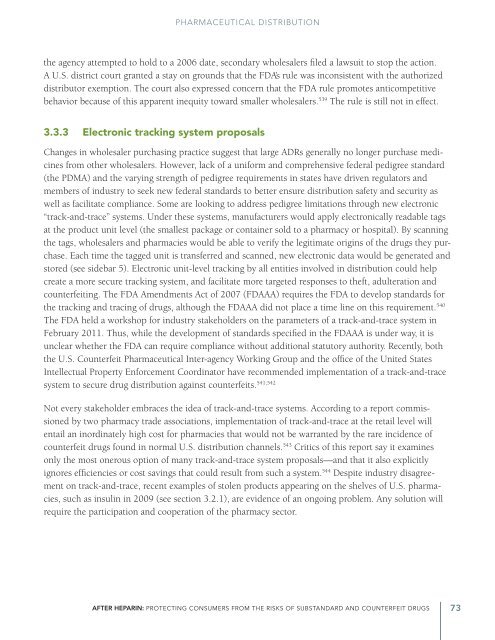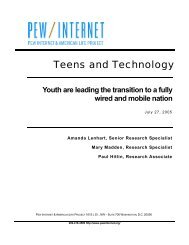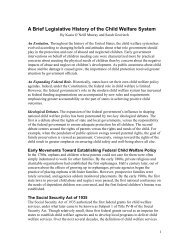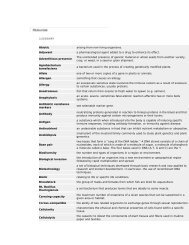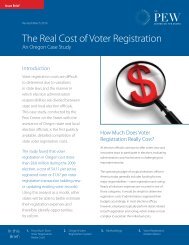After Heparin: - The Pew Charitable Trusts
After Heparin: - The Pew Charitable Trusts
After Heparin: - The Pew Charitable Trusts
Create successful ePaper yourself
Turn your PDF publications into a flip-book with our unique Google optimized e-Paper software.
PHARMACEUTICAL DISTRIBUTION<br />
the agency attempted to hold to a 2006 date, secondary wholesalers filed a lawsuit to stop the action.<br />
A U.S. district court granted a stay on grounds that the FDA’s rule was inconsistent with the authorized<br />
distributor exemption. <strong>The</strong> court also expressed concern that the FDA rule promotes anticompetitive<br />
behavior because of this apparent inequity toward smaller wholesalers. 539 <strong>The</strong> rule is still not in effect.<br />
3.3.3 Electronic tracking system proposals<br />
Changes in wholesaler purchasing practice suggest that large ADRs generally no longer purchase medicines<br />
from other wholesalers. However, lack of a uniform and comprehensive federal pedigree standard<br />
(the PDMA) and the varying strength of pedigree requirements in states have driven regulators and<br />
members of industry to seek new federal standards to better ensure distribution safety and security as<br />
well as facilitate compliance. Some are looking to address pedigree limitations through new electronic<br />
“track-and-trace” systems. Under these systems, manufacturers would apply electronically readable tags<br />
at the product unit level (the smallest package or container sold to a pharmacy or hospital). By scanning<br />
the tags, wholesalers and pharmacies would be able to verify the legitimate origins of the drugs they purchase.<br />
Each time the tagged unit is transferred and scanned, new electronic data would be generated and<br />
stored (see sidebar 5). Electronic unit-level tracking by all entities involved in distribution could help<br />
create a more secure tracking system, and facilitate more targeted responses to theft, adulteration and<br />
counterfeiting. <strong>The</strong> FDA Amendments Act of 2007 (FDAAA) requires the FDA to develop standards for<br />
the tracking and tracing of drugs, although the FDAAA did not place a time line on this requirement. 540<br />
<strong>The</strong> FDA held a workshop for industry stakeholders on the parameters of a track-and-trace system in<br />
February 2011. Thus, while the development of standards specified in the FDAAA is under way, it is<br />
unclear whether the FDA can require compliance without additional statutory authority. Recently, both<br />
the U.S. Counterfeit Pharmaceutical Inter-agency Working Group and the office of the United States<br />
Intellectual Property Enforcement Coordinator have recommended implementation of a track-and-trace<br />
system to secure drug distribution against counterfeits. 541,542<br />
Not every stakeholder embraces the idea of track-and-trace systems. According to a report commissioned<br />
by two pharmacy trade associations, implementation of track-and-trace at the retail level will<br />
entail an inordinately high cost for pharmacies that would not be warranted by the rare incidence of<br />
counterfeit drugs found in normal U.S. distribution channels. 543 Critics of this report say it examines<br />
only the most onerous option of many track-and-trace system proposals—and that it also explicitly<br />
ignores efficiencies or cost savings that could result from such a system. 544 Despite industry disagreement<br />
on track-and-trace, recent examples of stolen products appearing on the shelves of U.S. pharmacies,<br />
such as insulin in 2009 (see section 3.2.1), are evidence of an ongoing problem. Any solution will<br />
require the participation and cooperation of the pharmacy sector.<br />
<strong>After</strong> <strong>Heparin</strong>: PRotecting Consumers from the Risks of Substandard and Counterfeit Drugs 73


